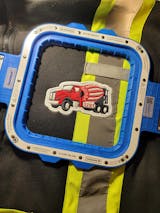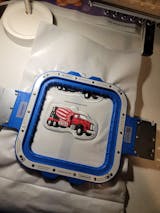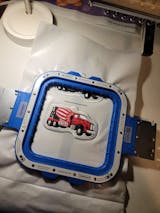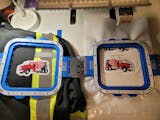1. Introduction: The Art of Sweatshirt Embroidery
Embroidering sweatshirts is more than just adding a splash of color—it's about transforming a cozy staple into a wearable work of art. In recent years, custom sweatshirt embroidery has exploded in popularity, from personalized names on cuffs to bold, intricate designs across the chest. But here's the catch: sweatshirts are made from stretchy, thick knits that challenge even seasoned embroiderers. Achieving crisp, professional results means mastering unique techniques—whether you prefer hand stitching or the precision of the best embroidery machines. In this guide, we’ll unravel the secrets to flawless sweatshirt embroidery, covering step-by-step methods, troubleshooting tips, creative design inspiration, and essential tool selection. Ready to elevate your favorite pullover? Let’s dive in and stitch with confidence!
Table of Contents
- 1. Introduction: The Art of Sweatshirt Embroidery
- 2. Essential Steps for Hand and Machine Embroidery Techniques
- 3. Overcoming Stretchy Fabric Challenges
- 4. Tools and Materials for Optimal Results
- 5. Creative Design Inspiration and Placement Strategies
- 6. Troubleshooting Common Sweatshirt Embroidery Issues
- 7. Conclusion: Perfecting Your Sweatshirt Embroidery
- 8. Frequently Asked Questions
2. Essential Steps for Hand and Machine Embroidery Techniques
Sweatshirt embroidery blends creativity with technical know-how. Whether you’re wielding a needle by hand or relying on the steady hum of a machine, following a systematic approach ensures your designs look sharp and last long. Let’s break down the process into actionable steps for both hand and machine embroidery.
2.1 Fabric Preparation and Design Transfer Methods
Before you thread a needle or fire up your embroidery machine, proper preparation is your secret weapon against distortion and disappointment.
Pre-Washing: Always pre-wash your sweatshirt. This simple step prevents post-embroidery shrinkage, which can warp your beautiful work. Iron out wrinkles for a smooth canvas.
Design Transfer:
- Simple Designs: Sketch directly onto the fabric using a fabric pencil or air-erase marker.
- Complex Patterns: Trace your design onto tracing paper, then transfer it to the fabric by rubbing over the lines, or use water-soluble stabilizers that you can print or trace onto and then stick to your sweatshirt.
- Placement Tips: For sleeves, a clever trick is to use a seam ripper to open the sleeve seam from about 1.5 to 2 inches above the cuff up to the elbow. This gives you a flat surface for easy hooping and stitching. After embroidery, simply sew the seam back together.
Hoop Selection: Choose an embroidery hoop slightly larger than your design. For knits, keep the fabric taut but not stretched—think trampoline, not tightrope. Only hoop one layer at a time, especially near necklines or cuffs, to avoid stitching through both sides.
Marking: Use temporary fabric pens to mark center points and alignment lines, ensuring your design sits exactly where you want it.
2.2 Hand Embroidery Execution: Stitches and Tension Control
Hand embroidery on sweatshirts is all about balancing creativity with control.
Stitch Selection:
- Backstitch: Ideal for lettering and outlines, creating a bubbly, bold effect.
- Chain Stitch: Perfect for yarn embroidery, adding texture and weight.
- Short Stitches: Prevent gapping and keep your work neat—especially important on stretchy knits.
Thread Preparation: Cut embroidery floss longer than you think you’ll need—about 36 inches is a safe bet. Split the floss for finer lines or double up for bold statements.
Tension Control: Keep your stitches snug but not tight. Over-stretching the fabric can cause puckering or distortion. Follow the natural flow of your design, working methodically from start to finish.
Finishing Touches: Knot the thread securely on the inside. After stitching, wash out any fabric marker and let the garment dry flat. For extra comfort and durability, consider adding a lightweight fusible interfacing to the inside of the sweatshirt.
2.3 Machine Embroidery: Stabilization and Precision Placement
Machine embroidery on sweatshirts calls for a blend of technology and technique.
Stabilization:
- Floating Technique: Hoop the stabilizer, not the sweatshirt itself. Float the fabric on top, securing it with temporary adhesive or pins. This method is especially helpful for bulky or stretchy sweatshirts.
- Tear-Away Stabilizers: Provide support during stitching but can be removed after, leaving the fabric soft.
- Fusible Power Mesh: Adds extra stability for complex or dense designs.
Placement and Alignment:
- Grid Alignment: Draw horizontal and vertical lines on your stabilizer to help align the design perfectly.
- Industry Standards: For center chest designs, position the top about 3 inches below the neckline. For sleeves, measure the design length (often around 6 inches for adults) and align accordingly.
Specialized Techniques:
- Sleeve Embroidery: If you don’t want to open the seam, carefully hoop through the sleeve opening, centering the design and maintaining even tension.
- Neckline Embroidery: Use peel-and-stick patterns, but avoid stitching above the seam line. Mark and trim transfer papers carefully to match the garment shape.
Finishing: After stitching, remove excess stabilizer and any temporary markings. Press the design from the inside using a pressing cloth to protect the threads and fabric.
3. Overcoming Stretchy Fabric Challenges
Stretchy sweatshirt fabrics are notorious for distorting embroidery designs. But with the right techniques, you can conquer puckering, waviness, and misalignment—ensuring your artwork stays crisp wash after wash.
3.1 Advanced Hooping Techniques for Knits
The embroidery hoops and frames you choose, and how you use them, can make or break your project.
Magnetic vs. Traditional Hoops:
Traditional screw-based hoops often struggle with thick, stretchy sweatshirts. They can leave hoop marks (“hoop burn”) and may not hold the fabric evenly, leading to sagging or shifting during stitching. Magnetic hoops, like those from Sewtalent, offer a game-changing solution:
- Even Tension Distribution: Magnets automatically adjust to fabric thickness, holding knits securely without overstretching.
- Prevents Distortion and Hoop Burn: The uniform pressure reduces the risk of visible marks and keeps your design flat and true.
- Ease of Use: Magnetic hoops are quick to set up and remove, saving time and frustration—especially when working on multiple garments.
| Fabric Type | Stabilizer Choice | Why It Works |
|---|---|---|
| Knits | Cut-away + adhesive spray | Prevents stretch distortion |
| Silk | Water-soluble film | Dissolves without residue |
| Leather | Tear-away + masking fabric | Cushions without sticking |
Floating and Basting:
For tricky areas like sleeves or thick fleece, use the floating technique with a basting stitch around the design to hold everything in place. This minimizes shifting and keeps your stitches precise.
3.2 Stabilizer Strategies for Different Sweatshirt Weights
Not all sweatshirts are created equal. Adjust your stabilizer game to match the fabric.
Cut-Away Stabilizers: Best for stretchy or heavy sweatshirts. They provide permanent support, preventing the fabric from snapping back and distorting your design after stitching.
Water-Soluble Stabilizers: Perfect for adding temporary support on top, especially for high-pile or textured knits. They wash away cleanly, leaving your embroidery crisp.
Dual-Layer Approaches: For extra thick or plush sweatshirts (like fleece), combine a cut-away stabilizer on the back with a water-soluble layer on top. This sandwich method keeps stitches from sinking and maintains clarity.
Fusible Interfacing: A YouTube favorite: iron-on mid-weight interfacing inside the sweatshirt before stitching. This not only stabilizes the fabric but also prevents stretching during embroidery—especially useful for necklines and thin areas.
Testing and Adjusting: Always test your stabilizer and hooping method on a scrap piece before committing to the final garment. This helps you fine-tune tension, stitch density, and placement for flawless results.
By mastering these foundational techniques and adapting to the quirks of sweatshirt fabrics, you’ll unlock a world of creative possibilities—turning every pullover into a canvas for self-expression. Ready to tackle your next project? Your embroidery adventure awaits!
4. Tools and Materials for Optimal Results
4.1 Hoop Innovations: Magnetic Technology Advantages
If you’ve ever battled with traditional screw hoops—struggling to keep thick sweatshirts taut, only to be left with hoop marks and uneven stitches—you’re not alone. Many embroiderers have found themselves frustrated, wasting time and even ruining garments. Enter magnetic embroidery hoops, a true game-changer for knits and sweatshirts.
Why Magnetic Hoops Outperform Traditional Screw Hoops
Traditional plastic hoops rely on manual screw tightening, which often leads to uneven tension, hoop burn (those dreaded marks left on fabric), and time-consuming adjustments. When embroidering sweatshirts, these issues are magnified by the fabric’s thickness and stretch. As highlighted in both research and real-world tutorials, magnetic hoops—like those from Sewtalent—offer a revolutionary alternative:
- Even, Automatic Tension: High-strength N50 magnets instantly adapt to varying fabric thickness, holding sweatshirts securely without overstretching. No more guesswork or sore fingers from endless tightening.
- Prevents Distortion and Hoop Burn: The magnetic force distributes pressure uniformly, protecting delicate knits from marks and preserving the fabric’s original shape.
- Time-Saving Efficiency: Magnetic hoops can reduce hooping time by up to 90%. What once took three minutes can now be done in just thirty seconds—an efficiency boost that’s especially valuable for commercial operations or anyone with a growing embroidery queue.
- Durability and Strength: Sewtalent’s magnetic hoops are constructed from PPSU (Polyphenylsulfone), an aircraft-grade engineering plastic, ensuring 40 times the lifespan of standard plastic hoops. These hoops are designed to withstand the rigors of daily use on thick, demanding fabrics.
Real-World Results: Consistency and Ease
YouTube creators and embroidery professionals consistently rave about the difference magnetic hoops make. Instead of struggling for 10–15 minutes to get a sweatshirt perfectly hooped, magnetic systems paired with hooping stations (like the HoopMaster) offer quick, repeatable, and precise placement every time. This not only saves time but also reduces costly mistakes—no more crooked or sagging designs.
Summary Table: Magnetic vs. Screw Hoops
| Feature | Magnetic Hoops (e.g., Sewtalent) | Traditional Screw Hoops |
|---|---|---|
| Tension Adjustment | Automatic, even with magnets | Manual, often uneven |
| Setup Time | ~30 seconds | 3–15 minutes |
| Fabric Protection | Prevents hoop burn | Can cause hoop marks |
| Durability | PPSU construction, very high | Standard plastic, lower lifespan |
| Ease of Use | Simple, quick, ergonomic | Requires dexterity and patience |
| Best for Thick/Stretchy Fabrics | Yes | Struggles with thick knits |
If you’re serious about embroidery on sweatshirts, investing in a magnetic hoop system is like upgrading from a flip phone to a smartphone—you’ll wonder how you ever managed without it.
4.2 Needle and Thread Specifications by Fabric Type
Embroidery is a dance between needle, thread, and fabric. Choosing the right partners for your sweatshirt projects ensures every stitch is smooth, secure, and stunning.
Needle Selection: Ballpoint is Best for Knits
- Ballpoint Needles: Specifically designed for knits and stretchy fabrics, ballpoint needles gently part the fibers rather than piercing them, preventing snags and holes. For sweatshirts, a size 75/11 or 80/12 embroidery needle is often ideal.
- Sharp Needles: Better suited for woven fabrics; avoid these for sweatshirts to prevent damage.
Thread Choices: Polyester vs. Rayon
- Polyester Thread: Highly recommended for sweatshirts due to its strength, stretch compatibility, and colorfastness. Polyester stands up to frequent washing and the natural movement of knit garments.
- Rayon Thread: Offers a beautiful sheen but is less durable and can be prone to breakage or fading with repeated laundering—best reserved for decorative pieces, not everyday wear.
Thread Weight Considerations
- Standard 40wt Embroidery Thread: The go-to for most sweatshirt projects, balancing visibility and smooth stitching.
- Heavier or Lighter Threads: Can be used for special effects, but always test on a fabric scrap first to ensure proper tension and coverage.
Pro Tip from YouTube Testing Protocols:
Before committing to a full design, run a test stitch on a scrap piece of sweatshirt fabric using your chosen needle and thread. This helps you fine-tune tension, stitch density, and ensures your materials play nicely together—saving you from mid-project headaches.
Supporting Tools: Marking and Alignment
- Water-Soluble Markers or Chalk: Essential for marking design placement, especially on dark or textured sweatshirts.
- Printable Stick-N-Wash Stabilizer: Great for transferring complex designs; simply print, stick, stitch, and wash away.
Summary Table: Needle and Thread Choices
| Fabric Type | Recommended Needle | Recommended Thread | Notes |
|---|---|---|---|
| Sweatshirt | Ballpoint 75/11–80/12 | Polyester 40wt | Strong, colorfast, resists abrasion |
| Woven Cotton | Sharp 75/11 | Rayon or Polyester | Rayon for sheen, polyester for strength |
| Fleece | Ballpoint 80/12 | Polyester 40wt | May require topper stabilizer |
Armed with the right hoop, needle, and thread, you’re set up for embroidery magic—no more broken threads, puckered stitches, or fabric drama.
5. Creative Design Inspiration and Placement Strategies
Sweatshirt embroidery in 2025 is all about bold self-expression, sustainability, and tactile delight. If you’re looking to move beyond basic monograms, let’s explore the trends, placements, and creative sparks that will set your work apart.
Sustainable Embroidery: Earthy and Ethical
Eco-conscious creators are embracing organic threads, upcycled sweatshirts, and natural dyes. Think botanical motifs, earthy palettes, and designs that celebrate nature. Upcycling vintage garments with fresh embroidery not only reduces waste but also infuses each piece with a unique story.
3D Textures and Tactile Techniques
Three-dimensional embroidery is taking center stage. Techniques like tufting, couching, and stumpwork add depth—imagine fluffy clouds, raised florals, or chunky abstract shapes that beg to be touched. These methods transform sweatshirts from simple wearables into interactive art.
Seasonal and Holiday Motifs
Seasonal designs never go out of style. For 2025, try:
- Winter: Whimsical snowmen, skating gnomes, or sparkling snowflakes.
- Spring: Floral gnomes, pastel blooms, and playful Easter eggs.
- Summer: Sunflowers, beach scenes, or patriotic popsicles.
- Fall: Pumpkins, scarecrows, and cozy autumnal quotes.
Bold Typography and Abstract Art
Typography is trending—embroider a favorite phrase, affirmation, or bold statement across the chest or sleeve. Abstract and geometric patterns, inspired by modern art, are also gaining traction. These designs pair perfectly with the oversized, boxy fits dominating streetwear.
Personalization and Storytelling
Custom names, initials, or even inside jokes turn a basic sweatshirt into a cherished keepsake. Vintage sports logos, cartoon characters, and meaningful quotes let you wear your story on your sleeve—literally.
Color Trends for 2025
- Vivid Hues: Deep reds, vibrant blues, and energetic greens for dramatic impact.
- Pastel Elegance: Lavenders, pinks, and soft neutrals for a gentle, dreamy vibe.
- Mocha Mousse: This sophisticated neutral is poised to be a standout shade in embroidery palettes.
Placement Strategies for Maximum Impact
- Left Chest: Classic for logos or monograms (3–4 inches wide), perfect for subtle personalization.
- Center Front: Go big with bold statements or intricate designs—think 3 inches below the neckline for adult sweatshirts.
- Sleeves: Ideal for vertical text, floral vines, or repeating motifs. For easy hooping, consider opening the sleeve seam or using a floating technique.
- Back: The ultimate canvas for large, artistic expressions.
Size Scaling and Proportion
Scale your design to fit the garment and the wearer. For children’s sweatshirts, smaller motifs placed closer to the collar look best. For adults, larger designs can command the center or back.
Quality Digitizing and Stitch Density
No matter how creative your design, professional digitizing is key. Optimize stitch density for sweatshirt fabric—too dense, and you risk puckering; too sparse, and the design may lack definition. Always test on a scrap before going all-in.
Let Your Imagination Run Wild
Whether you’re inspired by free machine embroidery designs, ModernGlam’s personalized cuffs, Skillshare’s abstract patterns, or your own wild ideas, remember: embroidery on sweatshirts is your playground. Mix techniques, play with placement, and don’t be afraid to break the “rules.” Your next masterpiece is just a stitch away.
6. Troubleshooting Common Sweatshirt Embroidery Issues
Even the most seasoned embroiderers face hiccups—puckering, thread breaks, or a design that’s just a little… off. Don’t let these challenges unravel your confidence. Here’s how to diagnose and fix the most common sweatshirt embroidery problems, so your work always looks professional.
6.1 Solving Tension and Puckering Problems
Puckering and Uneven Stitches: The Usual Suspects
Stretchy sweatshirt fabrics love to pucker if tension isn’t just right. Over-tightening the hoop, using the wrong stabilizer, or setting the machine’s tension too high can all spell disaster.
Quick Fixes:
- Hoop Gently: Fabric should be taut, not stretched. Let the hoop hold, not pull.
- Stabilizer Matters: Use a cut-away stabilizer sized to extend beyond the design. For extra support, pair with a water-soluble topper on textured knits.
- Adjust Machine Tension: If stitches look tight or the fabric gathers, lower the upper thread tension and check the bobbin. Test on a scrap before starting the real deal.
- Stitch Length: Shorter stitches are your friend, especially on curves. Long stitches can straighten out rounded shapes, making designs look angular and less refined.
Thread Breakage and Tangling
- Thread Path Check: Rethread your machine with the presser foot up, ensuring the thread moves smoothly through guides and tension discs.
- Bobbin Basics: Make sure the bobbin is wound and inserted correctly. Clean out any lint or stray threads from the bobbin case.
- Quality Thread and Needle: Use high-quality polyester thread and the correct needle for your fabric. A ballpoint needle helps prevent snags and breakage.
Bird’s Nesting (Thread Tangling Underneath)
- Handwheel Method: Slowly advance the needle by hand to observe each stitch. This helps pinpoint exactly where tangling starts.
- Clean and Maintain: Run a piece of unwaxed dental floss through the upper thread path to clear debris. Regular cleaning keeps your machine running smoothly.
6.2 Fixing Placement and Alignment Errors
Misaligned Designs: Prevention and Rescue
A crooked or misplaced design can ruin an otherwise perfect sweatshirt. The key is careful planning and double-checking before you stitch.
Placement Best Practices:
- Templates and Mockups: Print your design, fold it in half to find the center, and use it as a template on your garment. Mark the center and axis lines with a fabric-safe pen or reusable sticker.
- Industry Standards: For chest designs, 3 inches below the collar is a solid starting point—but adjust for design size and garment fit.
- Hooping Stations: Using a hooping station ensures consistent placement, especially when embroidering multiple garments or sizes.
When Things Go Wrong:
- Seam Reconstruction: If you need to remove a misplaced design, carefully unpick the stitches and reconstruct the seam, as shown in the Brother Innovis video lesson.
- Creative Fixes: If a spelling error or misalignment slips through, consider adding a patch, extra embellishment, or even a playful “oops” design—turning a mistake into a unique feature.
Final Quality Check:
- Trim stray threads and apply a fray check to thread ends for extra security.
- Always inspect your work before removing it from the hoop—catching issues early can save you from starting over.
Embrace the Learning Curve
Every mistake is a lesson in disguise. With patience, systematic troubleshooting, and avoiding the need for embroidery machine repair near me, you’ll soon master sweatshirt embroidery—one stitch at a time.
Ready to take your sweatshirt embroidery to the next level? With the right tools, creative inspiration, and troubleshooting know-how, your next project is sure to be a showstopper. Happy stitching!
7. Conclusion: Perfecting Your Sweatshirt Embroidery
Mastering embroidery on sweatshirts is a journey of precision, patience, and creative exploration. The secret to professional results with embroidery machine for sweatshirts lies in the fundamentals: proper stabilization to tame those stretchy knits, thoughtful stitch selection for clarity and texture, and vigilant tension control to prevent puckering or distortion. Whether you’re hand-stitching a heartfelt message or letting your embroidery machine work its magic, these core techniques are your foundation. But don’t stop there—let your imagination lead the way! Experiment with bold placements, playful motifs, and innovative materials. Every sweatshirt is a new canvas, and every project is a chance to refine your skills and express your unique style. Happy stitching!
8. Frequently Asked Questions
8.1 Q: Hand vs Machine Embroidery on Sweatshirts?
A: Both hand and machine embroidery have their place on sweatshirts, but each offers unique strengths. Hand embroidery shines for custom, small-scale designs—think delicate lettering on cuffs or whimsical motifs—where texture and a personal touch matter most. It’s also ideal for beginners or projects where time isn’t the main concern. Machine embroidery, on the other hand, is the go-to for larger, more intricate patterns and for anyone looking to produce consistent results quickly. Machines handle dense, multi-color designs with ease and are perfect for commercial or batch projects. In terms of durability, both methods can yield long-lasting results when paired with the right stabilizer and thread. The main difference comes down to time investment: hand embroidery is slower and more meditative, while machine embroidery delivers speed and precision.
8.2 Q: Washing and Care for Embroidered Sweatshirts?
A: To keep your embroidered sweatshirts looking fresh, a little extra care goes a long way. Always check the thread type—polyester threads are especially resilient and colorfast, making them a top choice for garments that see frequent washing. Turn your sweatshirt inside out before washing to protect the embroidery, and use cold water with a gentle cycle. Avoid harsh detergents and skip the bleach. When it’s time to dry, air drying is best, but if you must use a dryer, opt for a low heat setting. Press your sweatshirt from the inside or use a pressing cloth to shield the stitches from direct heat. With these simple steps, your embroidered designs will stay vibrant and intact, ready to be worn and admired again and again.







